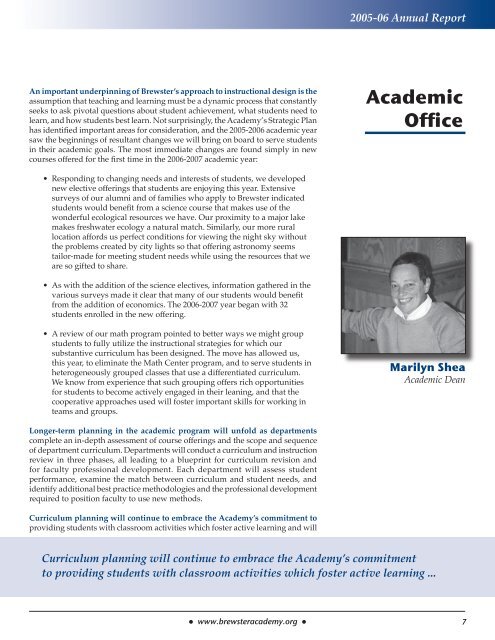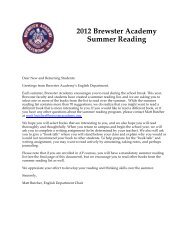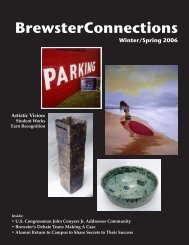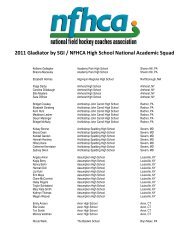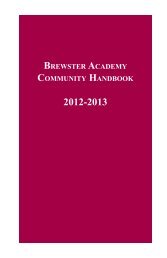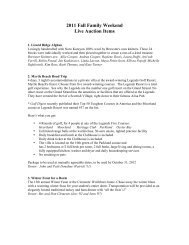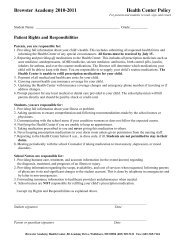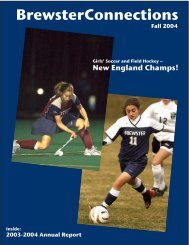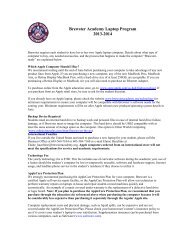BrewsterConnections - Brewster Academy
BrewsterConnections - Brewster Academy
BrewsterConnections - Brewster Academy
Create successful ePaper yourself
Turn your PDF publications into a flip-book with our unique Google optimized e-Paper software.
An important underpinning of <strong>Brewster</strong>’s approach to instructional design is the<br />
assumption that teaching and learning must be a dynamic process that constantly<br />
seeks to ask pivotal questions about student achievement, what students need to<br />
learn, and how students best learn. Not surprisingly, the <strong>Academy</strong>’s Strategic Plan<br />
has identified important areas for consideration, and the 2005-2006 academic year<br />
saw the beginnings of resultant changes we will bring on board to serve students<br />
in their academic goals. The most immediate changes are found simply in new<br />
courses offered for the first time in the 2006-2007 academic year:<br />
• Responding to changing needs and interests of students, we developed<br />
new elective offerings that students are enjoying this year. Extensive<br />
surveys of our alumni and of families who apply to <strong>Brewster</strong> indicated<br />
students would benefit from a science course that makes use of the<br />
wonderful ecological resources we have. Our proximity to a major lake<br />
makes freshwater ecology a natural match. Similarly, our more rural<br />
location affords us perfect conditions for viewing the night sky without<br />
the problems created by city lights so that offering astronomy seems<br />
tailor-made for meeting student needs while using the resources that we<br />
are so gifted to share.<br />
• As with the addition of the science electives, information gathered in the<br />
various surveys made it clear that many of our students would benefit<br />
from the addition of economics. The 2006-2007 year began with 32<br />
students enrolled in the new offering.<br />
• A review of our math program pointed to better ways we might group<br />
students to fully utilize the instructional strategies for which our<br />
substantive curriculum has been designed. The move has allowed us,<br />
this year, to eliminate the Math Center program, and to serve students in<br />
heterogeneously grouped classes that use a differentiated curriculum.<br />
We know from experience that such grouping offers rich opportunities<br />
for students to become actively engaged in their leaning, and that the<br />
cooperative approaches used will foster important skills for working in<br />
teams and groups.<br />
Longer-term planning in the academic program will unfold as departments<br />
complete an in-depth assessment of course offerings and the scope and sequence<br />
of department curriculum. Departments will conduct a curriculum and instruction<br />
review in three phases, all leading to a blueprint for curriculum revision and<br />
for faculty professional development. Each department will assess student<br />
performance, examine the match between curriculum and student needs, and<br />
identify additional best practice methodologies and the professional development<br />
required to position faculty to use new methods.<br />
Curriculum planning will continue to embrace the <strong>Academy</strong>’s commitment to<br />
providing students with classroom activities which foster active learning and will<br />
l www.brewsteracademy.org l<br />
2005-06 Annual Report<br />
academic<br />
Office<br />
marilyn shea<br />
Academic Dean<br />
Curriculum planning will continue to embrace the <strong>Academy</strong>’s commitment<br />
to providing students with classroom activities which foster active learning ...


